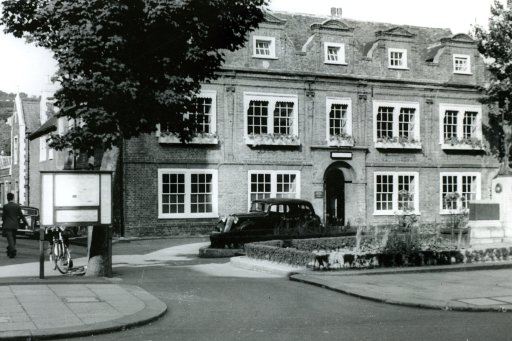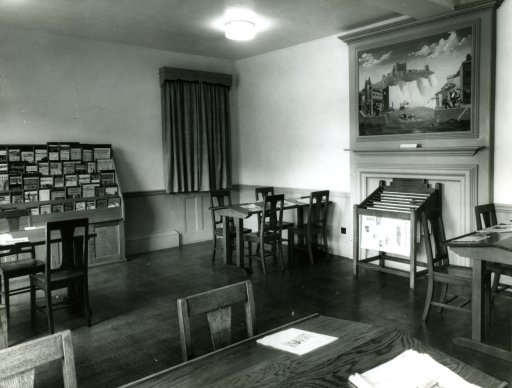
Maison Dieu House, Dover
Notes on the Reconstruction
This building constructed in 1665 was used as the residence of the Agent Victualler until 1815 and by Chief of Ordnance Department until 1834. Purchased by the Corporation in 1904 and used as offices, it was evacuated in 1949 in order that structural repairs could be carried out.
Despite the absence of the original entrance the front elevation is a fine example of the architecture of the period. Internally little of interest remains, but in three rooms the original panelling has been retained, and one fireplace reconstructed. The most important feature is the Jacobean staircase. Little but the newels and balustrade remain, and it would appear that it was not originally constructed for the building but adopted. The flights are not of equal length neither are the treads the same width throughout. The building has been scheduled by the Ministry of Works Department as a building of Historic Value.

Maison Dieu House, Dover
After the use of the building as an office was discontinued its future use was the subject of several reports to the Council, and it was eventually decided to render it structurally sound and convert to a Public Library.
A survey of the building showed that a small proportion of the repair work would be met by the War Damage Commission, but the majority of the damage was due to general deterioration and the ravages of the death-watch beetle. This insect which had probably been active in the oak timbers since the building was erected had considerably reduced the effective dimensions of the main oak beams, and had in some cases completely severed the 5" x 4" oak floor joists.
It was decided to retain the main floor beams, the average size of which were 12" x 10". Badly affected timbers were hacked away and the remainder was literally pickled with Cuprinol Furniture Beetle Destroyer. In order that the 1st floor would take the increased load rolled steel channels were bolted on either side of these beams, and new intermediate joists were carried on these channels. These intermediate joists were in softwood treated with Cuprinol S.Q.D Green preservative.
Repairs to the main roof were carried out without stripping the tiles and battens as these were generally sound having been renovated in the early nineteen thirties. In the north east corner, however, the roof and one wall was so badly damaged that the whole was demolished and rebuilt with new 2" bricks and new roof timbers. On the second floor short ends of 5" x 4" angle irons were bolted to the main oak beams, and the irons anchored to the main walls with rag bolts set in concrete. In order to assist in holding the whole of the front elevation together (this is badly bulged in some places) a reinforced concrete lintel was run along the entire front of the building immediately under the roof plate, and this lintel was anchored to the cross beams which in turn were fixed to the two large chimney stacks in the centre of the building.
The load bearing walls which in the main are two bricks thick were stitched together as necessary and where the beams carried particularly heavy loads these were carried down to the foundations by steel stanchions. Generally speaking however, no load bearing walls were removed (the majority of the internal partitioning was timber studding) so no heavy steel beams were required and a moderately uniform loading was preserved on the footings. This was particularly important as the ground is particularly bad and the foundations in the main consist of chalk blocks. The cost of suitably underpinning the whole building would have made the scheme prohibitive.
The structural work was started on 4th June and completed by 21st September.
Internal work consisted mainly of laying new floors and new wall plastering. As the walls were most irregular and subject to penetrating dampness the method used was timber battens, with Gyproc plasterboard and a single coat of plaster. Where possible the original wall panelling was retained, but it was necessary to dismantle it, treat the back with Cuprinol, and re-assemble. During this stage of the work the South Eastern Electricity Board were rewiring the whole of the building for light and power using screwed conduit throughout. The direct labour staff were installing the hot water heating system, and the cables were laid for both internal and G.P.O. telephones. During the progress of the work it was found necessary to completely rebuild the main staircase, using new timber in treads, risers and carriages. Work on the restoration of the oak beams started in late November and continued to Christmas. In some cases these lovely oak timbers had been covered with successive layers of paint to a thickness of 1/8". This generally impeded the devastation wrought by the death watch beetle, and with careful staining a pleasing effect has been obtained.
As far as possible existing timber was used in the first and second fixings, but in all about 5 standards of soft timber were used in the restoration and conversion.
The decoration using the old joinery presented a problem, as much was split, badly holed and in some cases out of line. Burning off of old paint took a considerable time, and in all some 4,000 hours were spent on this and the painting. All walls in the public areas were painted in preference to distemper to give a surface which is not only easy to keep clean, but is lasting.
With the exception of the small counter all the existing shelving was transferred from Biggin Hall, but the majority of furniture on show to the public including both counters is new and was constructed by contract. Face wood is first quality oak, but backing is of "Agba" and the whole was treated with Cuprinol by the manufacturers as a precaution againt attack by the death watch beetle.
The floor covering of staff areas was carried out by Messrs. Flashman using 3.5 m.m. linoleum. In order to minimise the transmission of sound from the Lending Library to rooms below this floor was insulated using a Fibreglass quilt under the floor and a 5/16" cork floor covering. For uniformity and sound suppression this cork flooring was used on all floors accessible to the public.

Lending Library
The work which took twelve months to complete was carried out with the close and most cordial co-operation from the Librarian and his Staff, the War Damage Commission and the Ancient Monuments Department of the Ministry of Works.

Reading Room
Borough Engineer's Office,
Brook House,
Dover.
June 1952.
[Author: Ron Bromley]
.The very serious condition of Maison Dieu House, Dover, a red brick Jacobean house, situated on the Dover-London Trunk Road A.2., adjoining the Maison Dieu, formed the subject of a report to the Town Council recently submitted by Mr. Philip V. Marchant, A.M.I.C.E., M.I.Mun.E., the Borough Engineer and Surveyor, after consultation with the Ministry of Works Architect in Charge of Ancient Monuments.
A few historic particulars regarding the fine old house, which is scheduled as an Ancient Monument, may be of interest in view of the fact that its future existence is endangered owing to the high estimated cost of restoration, although ways and means are being explored with a view to preserving the building.
Maison Dieu House was originally built as the residence of the Agent Victualler, Royal Navy, and was used by this official until after the Battle of Waterloo 1815, and subsequently by the Chief of the Ordnance Department until 1834. Later the building was disposed of as a private residence and eventually, in 1904, became the property of Corporation, since when it has been used as Municipal Offices, and is now used as the offices of the Borough Engineer and Surveyor's Department.
The Agent or Chief of the Victualling Office, was a much coveted office, the appointment being in the hands of the Lord Chancellor. The Maison Dieu, or Town Hall as it is today, was used as a Victualling Office for the Navy from the time of Queen Mary until 1834, after which it was bought by the Corporation.
Maison Dieu House is reputed to have been haunted like many other old houses, this belief being strengthened by the author of "Inglesby Legends", making the house the scene of his "Lay of the Old Woman Clothed in Grey".
In this narrative poem, it is related how an old woman in grey sits astride a barrel of wine, with a bag of gold held in her right hand, which she offers politely to all who happen to see her.
No-one amongst the Council's staff has yet been known to accept this generous offer.
Maison Dieu House dates from 1665, and externally, despite the absence of the original entrance doorway, the front elevation is robust and interesting of a rather rare type (Photograph No. 1), whilst internally there ia a very beautiful Jacobean staircase (Photograph No. 2).
Acknowledgements are due to Mr. B. A. Corrall, A.L.A., Borough Librarian, for supplying the information from which the historical notes relating to the building have been compiled.
[Another document about Maison Dieu House, dating from before the restoration. Handwritten date on typescript: 21 Feb 1948.]
.